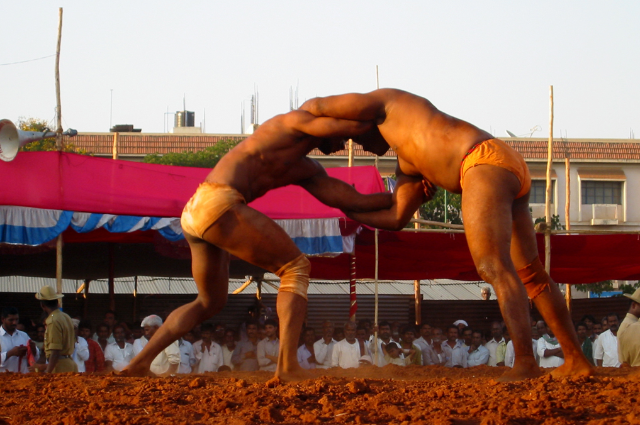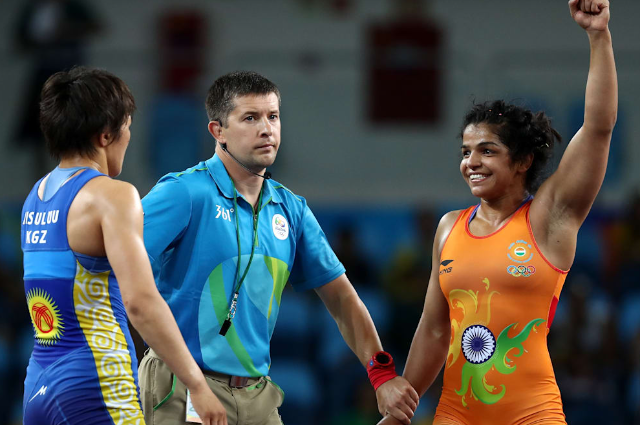Introduction:
India has a rich sports history that went back thousands of years. In different ancient texts or mythological epics, we find some popular names like 'Chaturanga' or dice games, archery, chariot race, horse race, etc. But wrestling was a kind of sport that was admired from the kings to the common people. Wrestling is counted as one of the oldest forms of combat in the world. Wrestling has been played and practiced since ancient times, famously known as ' Malla Yuddha'. It is a Sanskrit word. 'Malla' means wrestling or hand to hand combat and 'Yuddha' means war.
It is supposed that the modern form of wrestling or kushti originated from Malla yuddha. In Malla Yuddha two people engaged to overpower each other by wrestling, joint breaking, biting, punching, grabbing shoulders. This fight continued until one of the participants was knocked down completely or died in the worst case. The royals used to enjoy Malla yuddha as an entertaining timepass in their leisure time. At that time kings had their own 'Pahelwan' or Wrestlers who were kept under Royal maintenance for entertaining the king. From the elapsed period to the seven Olympic medals, Indian wrestling has covered a huge glorious journey.
History of Malla Yuddha:
We find so many literary references about wrestling in the Ramayana, Mahabharata, Puranas, and other regional literature. In Mahabharata, the second Pandava Bhimsen was a proficient wrestler apart from Gada yuddha. In Adi Parva, sabha Parva and Virat Parva, Bhim showed his excellency in wrestling. He wrestled with Magadha king Jarasandha who was an accomplished wrestler and slayed him by pressing his knees against Jarasandha 's backbone. Bhim also brutally killed Kichaka, the commander in chief of Matsya kingdom, in a bare hand using wrestling techniques as he tried to molest his beloved wife Draupadi.
In Ramayana, wrestling or Malla yuddha was figured between the Kiskindha king Bali and Lankadhipati Dashanan Ravan. Lord Hanuman also grabbed efficiency in wrestling. In Purana, Lord Srikrishna and his elder brother Lord Balaram were also skillful Wrestlers. Srikrishna punished two heavy weighted Wrestlers chanura and Mushtika by breaking their limbs who were sent by his oppressive maternal uncle Kamsa.
In the seventh century, Pallava King Narasimha Varman 1 of was an efficient Malla yoddha or wrestler. He was given the title 'Mahamalla' to dignify his skills. The 'Malla Purana' was the thirteenth-century deed on wrestling that was recorded during the era of Jyesthimalla clan describing wrestlers, skills, training, and specialized diet of the wrestlers.
Important terms and categories of Malla Yuddha:
In Malla Yuddha the yoddha or participants were well trained in Akhara or the traditional training school of wrestling. King Jarasandh's Akhara is still found in Bihar.
The akhara is basically a muddy floor where the wrestlers practice under the supervision of their Guru or teacher who teaches the styles like finger locking, joint breaking techniques which they used in wrestling. The students are allowed to wear only langotia or kaupina, a tiny loincloth to prevent hernia. They follow a strict Protein-rich diet and do exercises with pramada or mace and physical training like log pulling, weight lifting to nourish and strengthen muscles. Wrestlers devoted their lives by following a strict training regime and keeping away themselves from any toxic addiction and sexual attachment to keep their bodies pure as they grant their bodies like a temple.
Malla yuddha was categorised into four major divisions which were named after Hindu Gods and famous mythological characters. They are -
- Hanumanti which mainly concentrates on technical superiority is named after Lord Hanuman.
- Jambuvanti uses locks and holds to force the opponent into submission. This name is derived from Bear king Jambavan. It relies on grappling, choking, and locking.
- Jarasandhi concentrates on fierce combat like breaking limbs and joints, named after Magadha monarch Jarasandha.
- Bhimaseni focuses on sheer strength in fighting and was named after Pandav's brother the great Bhima.
Regional variants:
India is a widespread country with varieties of cultures and traditions. Wrestling has different variants in the different provinces of India. In entire north India, wrestling is famously known as Dangal or Kushti or Pahewani. In Gujarat, it is called Mala Khara. In the southern peninsular part, the format of wrestling is slightly different from others. It is named Malyutham in Tamil Nadu and Gatta Gusthi in Kerala, both are traditional folkstyle wrestling forms. In the northeastern states, Manipur and Mizoram also have their own wrestling formats. West Bengal once had a rich culture of kushti and Pahelwani.
Besides them, Musti yuddha and vajra mushti, two subtypes of wrestling, are still practiced in the oldest city of India, Benaras. Kolhapur, a small town of Maharashtra is now counted as the ' City of Wrestlers' due to uncountable numbers of kushti Akharas or training schools. Olympians like Sushil Kumar, Yogeshwar Dutt, Sakshi Malik got training from Kolhapur.
Notable Wrestlers from the present era:
There are a number of great wrestlers produced by Our motherland. From Dara Singh to Deepak Punia, the list of wrestlers who brought fame and pride to India is not short. We cannot forget the name of Great Gama or Ghulam Muhammad was the legendary World Champion wrestler of British India. K.D Jadhav was the first Olympic champion from India. Jatindra Charan Goho or Gobor Goho from Bengal also won fame in the international wrestling world.
Though wrestling was once counted as a men's game for a long time, our girls also grabbed international fame by their passionate performance. The two most famous Wrestlers from the Phogat clan, Geeta and Babita Phogat earned gold in the commonwealth games. Padmashree recipient Sakshi Malik won Bronze in Rio Olympics, 2016.
Conclusion:
There are so many traditional sports like Sataranj, Mardani khel, kalaripayattu, lathi khel, etc. available in India, some of them are still practiced or some of them obsoleted. Malla Yuddha is the ancestor of the present-day form of wrestling or kushti. Indian wrestlers are now showing their power-packed performances internationally and giving our motherland many proud moments. Wrestlers like Bajrang Punia, Yogeshwar Dutta, Sakshi Malik; all became the sports icon of India. We Indians are waiting eagerly for the first-ever gold medal in wrestling.


